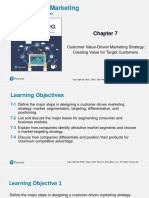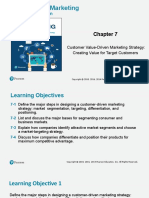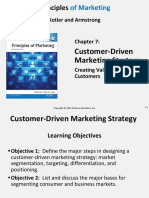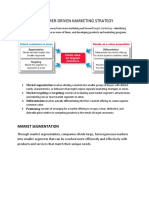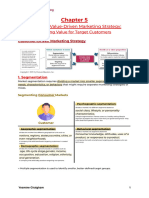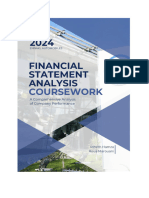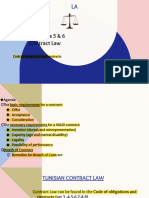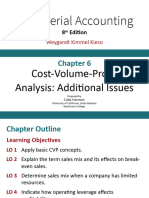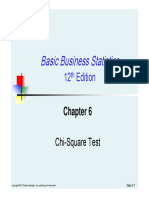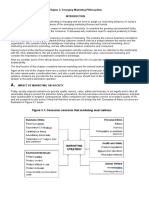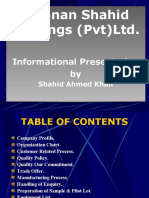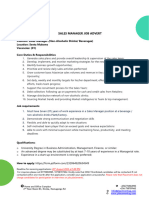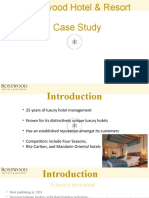0 ratings0% found this document useful (0 votes)
8 viewsMark 5
Mark 5
Uploaded by
Marouani RouaCopyright:
© All Rights Reserved
Available Formats
Download as PDF, TXT or read online from Scribd
Mark 5
Mark 5
Uploaded by
Marouani Roua0 ratings0% found this document useful (0 votes)
8 views38 pagesOriginal Title
mark5
Copyright
© © All Rights Reserved
Available Formats
PDF, TXT or read online from Scribd
Share this document
Did you find this document useful?
Is this content inappropriate?
Copyright:
© All Rights Reserved
Available Formats
Download as PDF, TXT or read online from Scribd
Download as pdf or txt
0 ratings0% found this document useful (0 votes)
8 views38 pagesMark 5
Mark 5
Uploaded by
Marouani RouaCopyright:
© All Rights Reserved
Available Formats
Download as PDF, TXT or read online from Scribd
Download as pdf or txt
You are on page 1of 38
Principles of Marketing
Eighteenth Edition
Chapter 5
Customer Value-Driven Marketing
Strategy: Creating Value for Target
Customers
Copyright © 2021, 2018, 2016 Pearson Education, Inc.
Learning Objectives
7.1 Define the major steps in designing a customer-driven
marketing strategy: market segmentation, targeting,
differentiation, and positioning.
7.2 List and discuss the major bases for segmenting
consumer and business markets.
7.3 Explain how companies identify attractive market
segments and choose a market-targeting strategy.
7.4 Discuss how companies differentiate and position their
products for maximum competitive advantage.
Copyright © 2021, 2018, 2016 Pearson Education, Inc.
Customer-Driven Marketing Strategy
Copyright © 2021, 2018, 2016 Pearson Education, Inc.
1. Segmentation
Copyright © 2021, 2018, 2016 Pearson Education, Inc.
Market Segmentation
Market segmentation requires dividing a market into
smaller segments with distinct needs, characteristics, or
behaviors that might require separate marketing strategies
or mixes.
The company identifies different ways to segment the
market and develops profiles of the resulting market
segments.
Copyright © 2021, 2018, 2016 Pearson Education, Inc.
1. Market Segmentation
Segmenting Consumer Markets
• Geographic segmentation: divides the market into different
geographical units such as nations, regions, states,
counties, cities, or even neighborhoods.
• Demographic segmentation: divides the market into
segments based on variables such as age, life-cycle stage,
gender, income, occupation, education, religion, ethnicity,
and generation.
• Psychographic segmentation: divides a market into
different segments based on social class, lifestyle, or
personality characteristics.
• Behavioral segmentation: divides a market into segments
based on consumer knowledge, attitudes, uses of a
product, or responses to a product.
Copyright © 2021, 2018, 2016 Pearson Education, Inc.
1. Market Segmentation
Psychographic segmentation
Lifestyle segmentation: Panera caters to a healthy eating lifestyle
segment of people who want more than just good-tasting food—they
want food that’s good for them, too.
Copyright © 2021, 2018, 2016 Pearson Education, Inc.
1. Market Segmentation
Behavioral Segmentation Benefit segmentation: Schwinn
• Occasions makes bikes for every benefit
• Benefits sought segment. For example, its e-
• User status bikes “help make the morning
• Usage rate commute or ride around town a
• Loyalty status little bit easier.”
Copyright © 2021, 2018, 2016 Pearson Education, Inc.
1. Market Segmentation
Multiple segmentation is used to identify smaller, better-defined target groups.
Experian’s Mosaic USA system classifies U.S. households into one of 71
lifestyle segments and 19 levels of affluence.
Using Acxiom’s Personicx segmentation system, marketers paint a surprisingly
precise picture of who you are and what you buy. Personicx clusters carry such
colorful names as “Skyboxes and Suburbans,” “Shooting Stars,” “Hard Chargers,”
“Soccer and SUVs,” “Raisin’ Grandkids,” “Truckin’ and Stylin’,” “Pennywise
Mortgagees,” and “Cartoons and Carpools.”
Copyright © 2021, 2018, 2016 Pearson Education, Inc.
1. Market Segmentation
Segmenting Business Markets
Consumer and business marketers use many of the same
variables to segment their markets.
Additional variables include:
• Customer operating characteristics
• Purchasing approaches
• Situational factors
• Personal characteristics
Copyright © 2021, 2018, 2016 Pearson Education, Inc.
1. Market Segmentation
Segmenting International Markets
• Geographic location involves grouping countries by regions such as
Western Europe, the Pacific Rim, the Middle East, or Africa.
Geographic segmentation assumes that nations close to one another
will have many common traits and behaviors, however there are many
exceptions:
The Dominican Republic and Brazil
Italy and Sweden
Many Central and South Americans don’t even speak Spanish.
Copyright © 2021, 2018, 2016 Pearson Education, Inc.
1. Market Segmentation
Segmenting International Markets
• Economic factors involve grouping countries by population income
levels or by their overall level of economic development. A country’s
economic structure shapes its population’s product and service needs
and, therefore, the marketing opportunities it offers.
• Political and legal factors involve segmenting by the type and
stability of the government, government receptivity to foreign firms,
monetary regulations, and the amount of bureaucracy.
• Cultural factors involve grouping markets according to common
languages, religions, values and attitudes, customs, and behavioral
patterns.
Copyright © 2021, 2018, 2016 Pearson Education, Inc.
1. Market Segmentation
Segmenting International Markets
Intermarket segmentation involves forming segments of
consumers who have similar needs and buying behaviors
even though they are located in different countries.
Also called cross-market segmentation
Copyright © 2021, 2018, 2016 Pearson Education, Inc.
1. Market Segmentation
Requirements for Effective Segmentation
• Measurable: The size, purchasing power, and profiles of
the segments can be measured.
• Accessible: The market segments can be effectively
reached and served.
• Substantial: The market segments are large or profitable
enough to serve.
• Differentiable: The segments are conceptually
distinguishable and respond differently to different
marketing mix elements and programs.
• Actionable: Effective programs can be designed for
attracting and serving the segments.
Copyright © 2021, 2018, 2016 Pearson Education, Inc.
2. Targeting
Copyright © 2021, 2018, 2016 Pearson Education, Inc.
Customer-Driven Marketing Strategy
Copyright © 2021, 2018, 2016 Pearson Education, Inc.
2. Market Targeting
The firm now has to evaluate the various segments and decide how many
and which segments it can serve best.
Evaluating Market Segments
• Segment size and growth
• Segment structural attractiveness
• Company objectives and resources
A target market is a set of buyers who share common
needs or characteristics that the company decides to
serve.
Copyright © 2021, 2018, 2016 Pearson Education, Inc.
2. Market Targeting
Figure 7.2 Market-Targeting Strategies
Copyright © 2021, 2018, 2016 Pearson Education, Inc.
2. Market Targeting
Selecting Target Market Segments
Undifferentiated marketing targets the whole market with
one offer.
• Mass marketing
• Focuses on common needs rather than what’s different
Copyright © 2021, 2018, 2016 Pearson Education, Inc.
2. Market Targeting
Selecting Target Market Segments
Differentiated marketing targets several different market segments and designs
separate offers for each.
• Goal: to achieve higher sales and stronger position
• More expensive than undifferentiated marketing
• Differentiated marketing: With more than 30 differentiated hotel brands,
Marriott International dominates the hotel industry, capturing a much larger
share of the travel and hospitality market than it could with any single brand
alone.
Copyright © 2021, 2018, 2016 Pearson Education, Inc.
2. Market Targeting
Selecting Target Markets Concentrated marketing: Nicher
Harry’s concentrates its resources
Concentrated (niche) marketing on direct-to-consumer sales of high-
targets a large share of a smaller quality razors and shaving products
market. to a value- and convenience-
• Limited company resources oriented segment of buyers
• Knowledge of the market previously not well served by giant
• More effective and efficient competitors like Gillette.
Copyright © 2021, 2018, 2016 Pearson Education, Inc.
2. Market Targeting
Selecting Target Market Segments
Micromarketing is the practice of tailoring products and
marketing programs to suit the tastes of specific individuals
and locations. It includes:
• Local marketing
• Individual marketing
An example of individual marketing is candy lovers can buy M&M’s embossed
with images of their kids or pets.
Copyright © 2021, 2018, 2016 Pearson Education, Inc.
2. Market Targeting
Selecting Target Market Segments
Local marketing involves tailoring brands and promotions to
the needs and wants of local customer segments.
• Cities
• Neighborhoods
• Stores
Copyright © 2021, 2018, 2016 Pearson Education, Inc.
2. Market Targeting
Selecting Target Markets Individual marketing: The
Individual marketing Rolls-Royce Bespoke design
involves tailoring products team works closely with
and marketing programs to individual customers to help
the needs and preferences of them create their own unique
individual customers. Rolls-Royces.
Also known as:
• One-to-one marketing
• Mass customization
Copyright © 2021, 2018, 2016 Pearson Education, Inc.
2. Market Targeting
How to Select Target Market Segments
Choosing a targeting strategy depends on
• Company resources: When the firm’s resources are limited,
concentrated marketing makes the most sense.
• Product variability: Undifferentiated marketing is more suited for
uniform products, such as grapefruit or steel.
• Product life-cycle stage: When a firm introduces a new product, it may
be practical to launch one version only, as undifferentiated marketing
or concentrated marketing may make the most sense. In the mature
stage of the product life cycle, however, differentiated marketing often
makes more sense.
• Market variability: Undifferentiated marketing is appropriate where
there is little market variability – most buyers have the same tastes,
buy the same amounts, and react the same way to marketing efforts.
• Competitor’s marketing strategies: When competitors use
undifferentiated marketing, a firm can gain an advantage by using
differentiated or concentrated marketing, focusing on the needs of
Copyright © 2021, 2018, 2016 Pearson Education, Inc.
buyers in specific segments.
Socially Responsible Target Marketing
Smart targeting helps companies become more efficient and
effective by focusing on the segments that they can satisfy
best and most profitably.
Targeting also benefits consumers: companies serve specific
groups of consumers with offers carefully tailored to their
needs.
Copyright © 2021, 2018, 2016 Pearson Education, Inc.
3&4. Differentiation and Positioning
Copyright © 2021, 2018, 2016 Pearson Education, Inc.
Customer-Driven Marketing Strategy
Copyright © 2021, 2018, 2016 Pearson Education, Inc.
3&4. Differentiation and Positioning
Product position is the way the product is defined by
consumers on important attributes.
Beyond deciding which segments of the market it will target,
the company must decide on a value proposition—how it will
create differentiated value for targeted segments and what
positions it wants to occupy in those segments.
Positioning: Sonos does more
than just sell speakers; it
unleashes “All the music on
earth, in every room of your
house, wirelessly.”
Copyright © 2021, 2018, 2016 Pearson Education, Inc.
3&4. Differentiation and Positioning
• Positioning maps
• In planning their differentiation and positioning strategies,
marketers often prepare perceptual positioning maps that
show consumer perceptions of their brands versus those of
competing products on important buying dimensions
• Eg., price and orientation (luxury versus performance).
• The size of each circle indicates the brand’s relative market
share.
Copyright © 2021, 2018, 2016 Pearson Education, Inc.
3&4. Differentiation and Positioning
Positioning maps show consumer perceptions of
marketer’s brands versus competing products on important
buying dimensions.
Figure 7.3 Positioning map: Large luxury SUVs
Copyright © 2021, 2018, 2016 Pearson Education, Inc.
3&4. Differentiation and Positioning
Choosing a Differentiation and Positioning Strategy
• Identifying a set of possible competitive advantages to
build a position
• Choosing the right competitive advantages
• Selecting an overall positioning strategy
• Communicating and delivering the chosen position to the
market
Copyright © 2021, 2018, 2016 Pearson Education, Inc.
3&4. Differentiation and Positioning
Choosing a Differentiation and Positioning Strategy
Competitive advantage is an advantage over competitors
gained by offering consumers greater value, either through
lower prices or by providing more benefits that justify higher
prices.
How Many Differences to Promote.
Many marketers think that companies should aggressively
promote only one benefit to the target market. Former
advertising executive Rosser Reeves, for example, said a
company should develop a unique selling proposition (USP)
for each brand and stick to it.
Copyright © 2021, 2018, 2016 Pearson Education, Inc.
3&4. Differentiation and Positioning
Choosing a Differentiation Services differentiation:
and Positioning Strategy Quicken Loans’ Rocket
Identifying a set of possible Mortgage doesn’t just offer
competitive advantages to mortgage loans; its online-
differentiate along the lines of: only interface lets users get a
loan decision in only minutes.
• Product
• Services
• Channels
• People
• Image
Copyright © 2021, 2018, 2016 Pearson Education, Inc.
3&4. Differentiation and Positioning
Choosing a Differentiation and Positioning Strategy
A competitive advantage should be:
• Important: The difference delivers a highly valued benefit
to target buyers.
• Distinctive: Competitors do not offer the difference, or the
company can offer it in a more distinctive way.
• Superior: The difference is superior to other ways that
customers might obtain the same benefit.
• Communicable: The difference is communicable and
visible to buyers.
• Preemptive: Competitors cannot easily copy the difference.
• Affordable: Buyers can afford to pay for the difference.
• Profitable: : The company can introduce the difference
Copyright © 2021, 2018, 2016 Pearson Education, Inc.
profitably
3&4. Differentiation and Positioning
Choosing a Differentiation and Positioning Strategy
Value proposition is the full mix of benefits upon which a
brand is positioned.
Figure 7.4 Possible Value Propositions
Copyright © 2021, 2018, 2016 Pearson Education, Inc.
3&4. Differentiation and Positioning
Choosing a Differentiation and Positioning Strategy
Positioning statement summarizes company or brand
positioning using this form: To (target segment and need)
our (brand) is (concept) that (point of difference)
Copyright © 2021, 2018, 2016 Pearson Education, Inc.
3&4. Differentiation and Positioning
Communicating and Delivering the Chosen Position
Choosing the positioning is often easier than implementing
the position.
Establishing a position or changing one usually takes a long
time.
Maintaining the position requires consistent performance
and communication.
Copyright © 2021, 2018, 2016 Pearson Education, Inc.
You might also like
- Cola Next: Meezan Beverages Private LimitedDocument21 pagesCola Next: Meezan Beverages Private LimitedImran Malik100% (3)
- MangoDocument11 pagesMangoVarun Mehrotra0% (1)
- Chapter 7Document69 pagesChapter 7jia mingNo ratings yet
- Kotler Pom17e PPT 07Document42 pagesKotler Pom17e PPT 07solehah sapieNo ratings yet
- Principles of Marketing: Seventeenth EditionDocument37 pagesPrinciples of Marketing: Seventeenth EditionHeap Ke XinNo ratings yet
- POM Chapter 7 - S14Document22 pagesPOM Chapter 7 - S14Ashar ZiaNo ratings yet
- Topic 3 Customer-Driven Marketing Strategy - Creating Value For Target CustomersDocument41 pagesTopic 3 Customer-Driven Marketing Strategy - Creating Value For Target Customers1221309443No ratings yet
- Chapter 7Document49 pagesChapter 7wuay1991No ratings yet
- Chapter 7 - Principles of Marketing 2023Document43 pagesChapter 7 - Principles of Marketing 2023nosiphokhanyile85No ratings yet
- CH 7Document20 pagesCH 7mknightblaze139No ratings yet
- Eighteenth Edition, Global Edition: Customer Value-Driven Marketing Strategy: Creating Value For Target CustomersDocument41 pagesEighteenth Edition, Global Edition: Customer Value-Driven Marketing Strategy: Creating Value For Target CustomersIrene Elfrida SNo ratings yet
- Eighteenth Edition, Global Edition: Customer Value-Driven Marketing Strategy: Creating Value For Target CustomersDocument51 pagesEighteenth Edition, Global Edition: Customer Value-Driven Marketing Strategy: Creating Value For Target Customerstedxitu2022No ratings yet
- Unit 2 - Lecture 5Document42 pagesUnit 2 - Lecture 5thaonguynnn22No ratings yet
- 06 Arm Mar7c PPT 06Document26 pages06 Arm Mar7c PPT 06cdfksmucentralNo ratings yet
- Solomon PPT 07 2023-2024-1Document36 pagesSolomon PPT 07 2023-2024-1mohamad.zhahranshahNo ratings yet
- BHN MKT Feb 21 - 7 - 220401 - 065821Document46 pagesBHN MKT Feb 21 - 7 - 220401 - 065821Vincent NathanielNo ratings yet
- Chapter 7S SRHDocument43 pagesChapter 7S SRHTrung PhạmNo ratings yet
- Segmenting, Targeting and Positioning: Building Right Relationships With Right CustomersDocument51 pagesSegmenting, Targeting and Positioning: Building Right Relationships With Right CustomerschaniNo ratings yet
- Lesson 4Document39 pagesLesson 4phython 1109No ratings yet
- Kolter - MM - AP - 7e - Chapter 08Document84 pagesKolter - MM - AP - 7e - Chapter 08LIU ZHONGKUN - FPEPNo ratings yet
- Chapter 7Document34 pagesChapter 7Nurul Athirah GhazaliNo ratings yet
- 2016.06.14 - Lecture 7 - Principles of Marketing - Chapter 7Document40 pages2016.06.14 - Lecture 7 - Principles of Marketing - Chapter 7nipoNo ratings yet
- Solomon Rprc11 PPT 07 AccessibleDocument35 pagesSolomon Rprc11 PPT 07 Accessiblertv4boxNo ratings yet
- Lec 5 Chap 7Document24 pagesLec 5 Chap 7Fahad RahmanNo ratings yet
- Week10 Bba261 Segmentation and TargetingDocument24 pagesWeek10 Bba261 Segmentation and TargetingnnazolgacNo ratings yet
- STP Market Segmentation Targeting PositioningDocument34 pagesSTP Market Segmentation Targeting PositioningJaymss MirandaNo ratings yet
- Identifying Market Segments and Selecting Target Markets: MarketingDocument18 pagesIdentifying Market Segments and Selecting Target Markets: MarketingYi XuanNo ratings yet
- IM1019 L4 Customer Value-Driven Marketing StrategyDocument44 pagesIM1019 L4 Customer Value-Driven Marketing StrategyDƯƠNG NGUYỄN THÁI BÌNHNo ratings yet
- Buyer BehaviourDocument54 pagesBuyer Behaviourfoysalmehadi131No ratings yet
- SegmentationDocument47 pagesSegmentationveera kaurNo ratings yet
- Market SegmentationDocument19 pagesMarket Segmentationnuplin.zain82% (11)
- Chap 4Document48 pagesChap 4abdullahkashiftkNo ratings yet
- Market SegmentationDocument17 pagesMarket Segmentationshaxrizodaisoyeva24No ratings yet
- Market Segmentation Targeting Positioning: Vu THN Ngocvth@uel - Edu.vnDocument43 pagesMarket Segmentation Targeting Positioning: Vu THN Ngocvth@uel - Edu.vnKhanh Trương Lê MaiNo ratings yet
- Chapter 5Document4 pagesChapter 5PRECIOUS JOY PATIGDASNo ratings yet
- Unit 2 - Lecture 5Document42 pagesUnit 2 - Lecture 5nhimynhon.sauNo ratings yet
- STP For Rural MarketsDocument16 pagesSTP For Rural MarketsGowri Sankar100% (5)
- Chapter Four: Market Segmentation, Targeting and PositioningDocument31 pagesChapter Four: Market Segmentation, Targeting and PositioningMohammed HassenNo ratings yet
- Customer-Driven Marketing Strategy: Market SegmentationDocument10 pagesCustomer-Driven Marketing Strategy: Market SegmentationNoman KhosaNo ratings yet
- Chapter 4 - Market and Competition - EUPDocument45 pagesChapter 4 - Market and Competition - EUPduyen.phan1401No ratings yet
- Unit 2 - Segmentation, Targeting, PositioningDocument40 pagesUnit 2 - Segmentation, Targeting, PositioningnayyarahmedchampanerwalaNo ratings yet
- Unit 2 (A) - 1Document47 pagesUnit 2 (A) - 1Alisha BhatnagarNo ratings yet
- Unit 2 (A)Document47 pagesUnit 2 (A)Alisha BhatnagarNo ratings yet
- Unit 2 (A)Document47 pagesUnit 2 (A)Alisha BhatnagarNo ratings yet
- Chapter 4 Segmentation,Targeting and PositioningDocument30 pagesChapter 4 Segmentation,Targeting and Positioningsyaannis653No ratings yet
- Pharmaceutical PromotionDocument25 pagesPharmaceutical PromotionZisan Ahmed ZikoNo ratings yet
- Chapter 7 PowerPointDocument43 pagesChapter 7 PowerPointMeeraNo ratings yet
- Chapter 5Document33 pagesChapter 5benrjebfatma18No ratings yet
- Customer Value: Driven Marketing StrategyDocument21 pagesCustomer Value: Driven Marketing StrategyIfrah BashirNo ratings yet
- Class Notes and Summary Marketing Management Chapter 7Document5 pagesClass Notes and Summary Marketing Management Chapter 7coolco270No ratings yet
- Marketing Management - CHAPTER 6Document17 pagesMarketing Management - CHAPTER 6Ewan DikoNo ratings yet
- Marketing Management NotesDocument42 pagesMarketing Management NotesTanmay GuptaNo ratings yet
- Armstrong Chap - 06-Segmentation 13 EdDocument31 pagesArmstrong Chap - 06-Segmentation 13 EdAqilahAzmiNo ratings yet
- CH 4Document38 pagesCH 4kichuubmcNo ratings yet
- Unit 2_NAMDocument22 pagesUnit 2_NAMsumit.229019No ratings yet
- Principle of Marketing CHAPTER 4Document9 pagesPrinciple of Marketing CHAPTER 4Alemayehu gabisaNo ratings yet
- Chapter 5 MKTDocument5 pagesChapter 5 MKTbouchahdamajd7No ratings yet
- Target MarketingDocument44 pagesTarget Marketingsampathgunasekara031No ratings yet
- Kotler 18e Accessible PowerPoint 01Document52 pagesKotler 18e Accessible PowerPoint 01Mohamed HamedNo ratings yet
- Niche Marketing Made Simple: Target Your Audience Better With These TipsFrom EverandNiche Marketing Made Simple: Target Your Audience Better With These TipsNo ratings yet
- Niche Marketing: Strategies for Segmenting and Serving Specific Audiences: Marketing 360°: The Power of Modern MarketingFrom EverandNiche Marketing: Strategies for Segmenting and Serving Specific Audiences: Marketing 360°: The Power of Modern MarketingNo ratings yet
- FSA COURSEWORK (1) (1)Document19 pagesFSA COURSEWORK (1) (1)Marouani RouaNo ratings yet
- 4- DCF Valuation (Blank)Document8 pages4- DCF Valuation (Blank)Marouani RouaNo ratings yet
- Chap 5 Contract LawDocument32 pagesChap 5 Contract LawMarouani RouaNo ratings yet
- ch06 - CVP Analysis Additional IssuesDocument70 pagesch06 - CVP Analysis Additional IssuesMarouani RouaNo ratings yet
- Chapter 6 1Document69 pagesChapter 6 1Marouani RouaNo ratings yet
- Chapter 5 Inflation TEST BANK 1Document20 pagesChapter 5 Inflation TEST BANK 1Marouani RouaNo ratings yet
- Procurement CH 5Document55 pagesProcurement CH 5KalkidanNo ratings yet
- Concept of KaizenDocument3 pagesConcept of KaizenmaachudaapniNo ratings yet
- SMM Module 3Document4 pagesSMM Module 3love annderNo ratings yet
- Carzwash Case StudyDocument5 pagesCarzwash Case StudyApple Santos MabagosNo ratings yet
- The Seven Value Stream Mapping Tools Peter Hinesand Nick Rich IJOPM1997Document29 pagesThe Seven Value Stream Mapping Tools Peter Hinesand Nick Rich IJOPM1997jasmineNo ratings yet
- Ramaswamy PPT CH 22 - EdDocument8 pagesRamaswamy PPT CH 22 - EdkrishaniNo ratings yet
- Raju Omlet: Expanding in The United Arab Emirates Case StudyDocument2 pagesRaju Omlet: Expanding in The United Arab Emirates Case StudyZahra TariqNo ratings yet
- ERP Implementation FrameworkDocument29 pagesERP Implementation Frameworkkavya sreeNo ratings yet
- Mannan Shahid Forgings (PVT) LTD.: Informational Presentation byDocument29 pagesMannan Shahid Forgings (PVT) LTD.: Informational Presentation bybhimra100% (1)
- Lectra Fashion Brochure Flex Offer enDocument8 pagesLectra Fashion Brochure Flex Offer enPratama TanadaNo ratings yet
- Marketing Plan RamosDocument9 pagesMarketing Plan RamosEmie RamosNo ratings yet
- I ProcurementDocument50 pagesI Procurementnarasimhulu.aNo ratings yet
- Quality Requirements For Sub ContractorDocument103 pagesQuality Requirements For Sub ContractorMohammed100% (2)
- Sales Manager Job Advert - Placement SolutionsDocument1 pageSales Manager Job Advert - Placement Solutionstutorfelix777No ratings yet
- 626a9f4c1890fc00104b79ce-1651154965-MODULE 3Document6 pages626a9f4c1890fc00104b79ce-1651154965-MODULE 3Marcelo Santos IINo ratings yet
- Request NDT Trunkline 03-11-2022Document1 pageRequest NDT Trunkline 03-11-2022Ferdie OSNo ratings yet
- Ather's Price StrategyDocument3 pagesAther's Price Strategyrahul kumarNo ratings yet
- UntitledDocument26 pagesUntitledDhapaDanNo ratings yet
- Plan For TrainingDocument78 pagesPlan For TrainingRakeshchowdary SingamaneniNo ratings yet
- 07 Activity 1Document1 page07 Activity 1Zoe TylersNo ratings yet
- Jurnal SkripsiDocument20 pagesJurnal SkripsiRahma AzizahNo ratings yet
- MRP - Chapter 5Document7 pagesMRP - Chapter 5huy7n-35No ratings yet
- TiwagoxDocument3 pagesTiwagoxprabhuNo ratings yet
- Li FungDocument2 pagesLi FungcerlaybabaNo ratings yet
- Unit 8 Business Process Re-Engineering: StructureDocument30 pagesUnit 8 Business Process Re-Engineering: StructurePrashant SatamNo ratings yet
- EOQ Problem SolvingDocument4 pagesEOQ Problem Solvingmishal zikria100% (1)
- Surya Kiran Singh ResumeDocument4 pagesSurya Kiran Singh Resumesurya kiranNo ratings yet
- Additive Manufacturing ProcessDocument12 pagesAdditive Manufacturing Processp.bansodNo ratings yet



